Incorporating Stepping Stone Establishment into Rural Ecological Security Pattern Optimization: A Water–Energy–Food Coupling Perspective
Abstract
1. Introduction
2. Materials and Methods
2.1. Case Study Area
2.2. Dataset
3. Framework and Methodology
3.1. Methodological Framework
3.2. Identifying Ecological Sources
3.2.1. Selecting and Assessing ESs
3.2.2. Identifying Ecological Sources Based on CCD of ESs
3.3. Constructing Ecological Resistance Surface
3.4. Extracting Ecological Corridors and Nodes
3.5. Optimizing Ecological Network by Incorporating ESSs
3.5.1. Identifying ESSs
3.5.2. Evaluating Source Connectivity Before and After Optimization
3.6. Constructing Rural ESP with Optimized Network
4. Results
4.1. Ecological Sources
4.1.1. Assessment of Selected ESs
4.1.2. WF-CS-FP Coupling Coordination Analysis
4.1.3. Identification of Ecological Sources
4.2. Resistance Surface
4.3. Ecological Corridor, Pinch, and Barrier Points
4.4. Ecological Stepping Stones
4.5. Ecological Network Optimization Based on Incorporating ESSs
4.6. Ecological Security Pattern
- (1)
- One Core
- (2)
- Three Zones
- (3)
- Four Belts
- (4)
- Multiple Nodes
5. Discussion
5.1. Rural Ecological Conservation Practices and Implications from a W-E-F Coupled Coordination Perspective
5.2. The Selection and Advantages of Stepping Stones in Rural ESP Construction
5.3. Management Practices and Directions in Rural ESP
5.4. Limitations and Further Prospects
6. Conclusions
Supplementary Materials
Author Contributions
Funding
Data Availability Statement
Conflicts of Interest
References
- Costanza, R.; D’Arge, R.; De Groot, R.; Farber, S.; Grasso, M.; Hannon, B.; Limburg, K.; Naeem, S.; O’Neill, R.V.; Paruelo, J.; et al. The value of the world’s ecosystem services and natural capital. Nature 1997, 387, 253–260. [Google Scholar] [CrossRef]
- Ding, T.; Chen, J. Evaluating supply-demand matching of ecosystem services considering water-energy-food nexus and synergies/trade-offs in the Hangzhou of China. Environ. Sci. Pollut. Res. 2023, 30, 54568–54585. [Google Scholar] [CrossRef] [PubMed]
- Jia, Q.; Jiao, L.; Lian, X.; Wang, W. Linking supply-demand balance of ecosystem services to identify ecological security patterns in urban agglomerations. Sustain. Cities Soc. 2023, 92. [Google Scholar] [CrossRef]
- Zhao, Y.; He, L.; Bai, W.; He, Z.; Luo, F.; Wang, Z. Prediction of ecological security patterns based on urban expansion: A case study of Chengdu. Ecol. Indic. 2024, 158, 111467. [Google Scholar] [CrossRef]
- Wen, J.; Hou, K. Research on the progress of regional ecological security evaluation and optimization of its common limitations. Ecol. Indic. 2021, 127. [Google Scholar] [CrossRef]
- Yu, K. Security patterns and surface model in landscape ecological planning. Landsc. Urban Plan. 1996, 36, 1–17. [Google Scholar] [CrossRef]
- Ogden, J.C.; Baldwin, J.D.; Bass, O.L.; Browder, J.A.; Cook, M.I.; Frederick, P.C.; Frezza, P.E.; Galvez, R.A.; Hodgson, A.B.; Meyer, K.D.; et al. Waterbirds as indicators of ecosystem health in the coastal marine habitats of Southern Florida: 2. Conceptual ecological models. Ecol. Indic. 2014, 44, 128–147. [Google Scholar] [CrossRef]
- Kubacka, M.; Żywica, P.; Vila Subirós, J.; Bródka, S.; Macias, A. How do the surrounding areas of national parks work in the context of landscape fragmentation? A case study of 159 protected areas selected in 11 EU countries. Land Use Policy 2022, 113, 105910. [Google Scholar] [CrossRef]
- Jiang, H.; Peng, J.; Xu, D.; Tang, H. Constructing ecological security patterns with differentiated management intensity based on multifunctional landscape identification and multi-criteria decision-making. Glob. Ecol. Conserv. 2024, 50, e02862. [Google Scholar] [CrossRef]
- Hu, Y.; Gong, J.; Li, X.; Song, L.; Zhang, Z.; Zhang, S.; Zhang, W.; Dong, J.; Dong, X. Ecological security assessment and ecological management zoning based on ecosystem services in the West Liao River Basin. Ecol. Eng. 2023, 192, 106973. [Google Scholar] [CrossRef]
- Peng, J.; Zhao, H.; Liu, Y.; Wu, J. Research progress and prospect on regional ecological security pattern construction. Geogr. Res. 2017, 36, 407–419. [Google Scholar]
- Ding, M.; Liu, W.; Xiao, L.; Zhong, F.; Lu, N.; Zhang, J.; Zhang, Z.; Xu, X.; Wang, K. Construction and optimization strategy of ecological security pattern in a rapidly urbanizing region: A case study in central-south China. Ecol. Indic. 2022, 136, 108604. [Google Scholar] [CrossRef]
- Xiang, H.; Zhang, J.; Mao, D.; Wang, M.; Yu, F.; Wang, Z.; Li, H. Optimizing ecological security patterns considering zonal vegetation distribution for regional sustainability. Ecol. Eng. 2023, 194, 107055. [Google Scholar] [CrossRef]
- Wang, N.; Zhao, Y. Construction of an ecological security pattern in Jiangnan water network area based on an integrated Approach: A case study of Gaochun, Nanjing. Ecol. Indic. 2024, 158, 111314. [Google Scholar] [CrossRef]
- Peng, J.; Pan, Y.; Liu, Y.; Zhao, H.; Wang, Y. Linking ecological degradation risk to identify ecological security patterns in a rapidly urbanizing landscape. Habitat Int. 2018, 71, 110–124. [Google Scholar] [CrossRef]
- Huang, X.; Wang, H.; Shan, L.; Xiao, F. Constructing and optimizing urban ecological network in the context of rapid urbanization for improving landscape connectivity. Ecol. Indic. 2021, 132, 108319. [Google Scholar] [CrossRef]
- Liu, H.; Wang, Z.; Zhang, L.; Tang, F.; Wang, G.; Li, M. Construction of an ecological security network in the Fenhe River Basin and its temporal and spatial evolution characteristics. J. Clean. Prod. 2023, 417, 137961. [Google Scholar] [CrossRef]
- Wei, B.; Kasimu, A.; Fang, C.; Reheman, R.; Zhang, X.; Han, F.; Zhao, Y.; Aizizi, Y. Establishing and optimizing the ecological security pattern of the urban agglomeration in arid regions of China. J. Clean. Prod. 2023, 427, 139301. [Google Scholar] [CrossRef]
- Mu, H.; Li, X.; Ma, H.; Du, X.; Huang, J.; Su, W.; Yu, Z.; Xu, C.; Liu, H.; Yin, D.; et al. Evaluation of the policy-driven ecological network in the Three-North Shelterbelt region of China. Landsc. Urban Plan. 2022, 218, 104305. [Google Scholar] [CrossRef]
- Fagerholm, N.; Torralba, M.; Moreno, G.; Girardello, M.; Herzog, F.; Aviron, S.; Burgess, P.; Crous-Duran, J.; Ferreiro-Domínguez, N.; Graves, A.; et al. Cross-site analysis of perceived ecosystem service benefits in multifunctional landscapes. Glob. Environ. Chang. 2019, 56, 134–147. [Google Scholar] [CrossRef]
- Li, J.; Geneletti, D.; Wang, H. Understanding supply-demand mismatches in ecosystem services and interactive effects of drivers to support spatial planning in Tianjin metropolis, China. Sci. Total Environ. 2023, 895, 165067. [Google Scholar] [CrossRef] [PubMed]
- Ding, T.; Chen, J.; Fang, L.; Ji, J. Identifying and optimizing ecological security patterns from the perspective of the water-energy-food nexus. J. Hydrol. 2024, 632, 130912. [Google Scholar] [CrossRef]
- Xiao, R.; Lin, M.; Fei, X.; Li, Y.; Zhang, Z.; Meng, Q. Exploring the interactive coercing relationship between urbanization and ecosystem service value in the Shanghai–Hangzhou Bay Metropolitan Region. J. Clean. Prod. 2020, 253, 119803. [Google Scholar] [CrossRef]
- Xu, D.; Peng, J.; Jiang, H.; Dong, J.; Liu, M.; Chen, Y.; Wu, J.; Meersmans, J. Incorporating barriers restoration and stepping stones establishment to enhance the connectivity of watershed ecological security patterns. Appl. Geogr. 2024, 170, 103347. [Google Scholar] [CrossRef]
- Herrera, L.P.; Sabatino, M.C.; Jaimes, F.R.; Saura, S. Landscape connectivity and the role of small habitat patches as stepping stones: An assessment of the grassland biome in South America. Biodivers. Conserv. 2017, 26, 3465–3479. [Google Scholar] [CrossRef]
- Wu, J.; Zhang, S.; Luo, Y.; Wang, H.; Zhao, Y. Assessment of risks to habitat connectivity through the stepping-stone theory: A case study from Shenzhen, China. Urban For. Urban Green. 2022, 71, 127532. [Google Scholar] [CrossRef]
- Peng, J.; Yang, Y.; Liu, Y.; Hu, Y.n.; Du, Y.; Meersmans, J.; Qiu, S. Linking ecosystem services and circuit theory to identify ecological security patterns. Sci. Total Environ. 2018, 644, 781–790. [Google Scholar] [CrossRef] [PubMed]
- Wimberly, M.C.; Narem, D.M.; Bauman, P.J.; Carlson, B.T.; Ahlering, M.A. Grassland connectivity in fragmented agricultural landscapes of the north-central United States. Biol. Conserv. 2018, 217, 121–130. [Google Scholar] [CrossRef]
- Poli, C.; Hightower, J.; Fletcher, R.J., Jr. Validating network connectivity with observed movement in experimental landscapes undergoing habitat destruction. J. Appl. Ecol. 2020, 57, 1426–1437. [Google Scholar] [CrossRef]
- Hoff, H. Understanding the nexus. In Proceedings of the Bonn2011 Conference: The Water, Energy and Food Security Nexus, Stockholm Environment Institute, Stockholm, Sweden, 16–18 November 2011. [Google Scholar]
- Cansino-Loeza, B.; Tovar-Facio, J.; Ponce-Ortega, J.M. Stochastic optimization of the water-energy-food nexus in disadvantaged rural communities to achieve the sustainable development goals. Sustain. Prod. Consum. 2021, 28, 1249–1261. [Google Scholar] [CrossRef]
- Schmidt, J.I.; Johnson, B.; Huntington, H.P.; Whitney, E. A framework for assessing food-energy-water security: A FEW case studies from rural Alaska. Sci. Total Environ. 2022, 821, 153355. [Google Scholar] [CrossRef]
- Medina-Santana, A.A.; Flores-Tlacuahuac, A.; Cárdenas-Barrón, L.E.; Fuentes-Cortés, L.F. Optimal design of the water-energy-food nexus for rural communities. Comput. Chem. Eng. 2020, 143, 107120. [Google Scholar] [CrossRef]
- Zhang, Y.; Wang, Y. Water–Energy–Food Nexus in the Yellow River Basin of China under the Influence of Multiple Policies. Land 2024, 13, 1356. [Google Scholar] [CrossRef]
- Guo, S.; Zhang, F.; Engel, B.A.; Wang, Y.; Guo, P.; Li, Y. A distributed robust optimization model based on water-food-energy nexus for irrigated agricultural sustainable development. J. Hydrol. 2022, 606, 127394. [Google Scholar] [CrossRef]
- Biggs, E.M.; Bruce, E.; Boruff, B.; Duncan, J.M.A.; Horsley, J.; Pauli, N.; McNeill, K.; Neef, A.; Van Ogtrop, F.; Curnow, J.; et al. Sustainable development and the water–energy–food nexus: A perspective on livelihoods. Environ. Sci. Policy 2015, 54, 389–397. [Google Scholar] [CrossRef]
- Sukhwani, V.; Shaw, R.; Mitra, B.K.; Yan, W. Optimizing Food-Energy-Water (FEW) nexus to foster collective resilience in urban-rural systems. Prog. Disaster Sci. 2019, 1, 100005. [Google Scholar] [CrossRef]
- Zhang, X.; Vesselinov, V.V. Integrated modeling approach for optimal management of water, energy and food security nexus. Adv. Water Resour. 2017, 101, 1–10. [Google Scholar] [CrossRef]
- Ren, Y.; Qu, Z.; Du, Y.; Xu, R.; Ma, D.; Yang, G.; Shi, Y.; Fan, X.; Tani, A.; Guo, P.; et al. Air quality and health effects of biogenic volatile organic compounds emissions from urban green spaces and the mitigation strategies. Environ. Pollut. 2017, 230, 849–861. [Google Scholar] [CrossRef]
- Giannico, V.; Spano, G.; Elia, M.; D’Este, M.; Sanesi, G.; Lafortezza, R. Green spaces, quality of life, and citizen perception in European cities. Environ. Res. 2021, 196, 110922. [Google Scholar] [CrossRef]
- Tang, W.; Liu, S.; Feng, S.; Xiao, F.; Ogbodo, U.S. Evolution and improvement options of ecological environmental quality in the world’s largest emerging urban green heart as revealed by a new assessment framework. Sci. Total Environ. 2023, 858, 159715. [Google Scholar] [CrossRef]
- Jiang, W.; Chen, Z.; Lei, X.; He, B.; Jia, K.; Zhang, Y. Simulation of urban agglomeration ecosystem spatial distributions under different scenarios: A case study of the Changsha–Zhuzhou–Xiangtan urban agglomeration. Ecol. Eng. 2016, 88, 112–121. [Google Scholar] [CrossRef]
- Lu, J.; Jiao, S.; Han, Z.; Yin, J. Promoting ecological restoration of deeply urbanized hilly areas: A multi-scale ecological networks approach. Ecol. Indic. 2023, 154, 110655. [Google Scholar] [CrossRef]
- Kühn, M. Greenbelt and Green Heart: Separating and integrating landscapes in European city regions. Landsc. Urban Plan. 2003, 64, 19–27. [Google Scholar] [CrossRef]
- Finnegan, N.J.; Schumer, R.; Finnegan, S. A signature of transience in bedrock river incision rates over timescales of 104–107 years. Nature 2014, 505, 391–394. [Google Scholar] [CrossRef]
- Yan, F.; Shangguan, W.; Zhang, J.; Hu, B. Depth-to-bedrock map of China at a spatial resolution of 100 meters. Sci. Data 2020, 7, 2. [Google Scholar] [CrossRef] [PubMed]
- Chen, J.; Wang, H.; Liu, G.; Bai, Y. Evaluation of Ecosystem Services and Its Adaptive Policies in the Hangjiahu Region Under Water-Energy-Food Nexus. Resour. Environ. Yangtze Basin 2019, 28, 542–553. [Google Scholar]
- Yang, K.; Han, Q.; de Vries, B. Urbanization effects on the food-water-energy nexus within ecosystem services: A case study of the Beijing-Tianjin-Hebei urban agglomeration in China. Ecol. Indic. 2024, 160, 111845. [Google Scholar] [CrossRef]
- Lyu, R.; Yuan, M.; Fu, X.; Tang, M.; Qu, L.; Yin, Z.; Wu, G. The Trade-Offs and Constraints of Watershed Ecosystem Services: A Case Study of the West Liao River Basin in China. Land 2025, 14, 119. [Google Scholar] [CrossRef]
- Li, P.; Liu, C.; Yu, C.; Gao, C.; Sun, W. The delineation and effects of urban development boundaries under ecological constraints: The case of urban Nanjing, China. Ecol. Indic. 2024, 167, 112499. [Google Scholar] [CrossRef]
- Cao, C.; Luo, Y.; Xu, L.; Xi, Y.; Zhou, Y. Construction of ecological security pattern based on InVEST-Conefor-MCRM: A case study of Xinjiang, China. Ecol. Indic. 2024, 159, 111647. [Google Scholar] [CrossRef]
- Pathak, S.; Ojha, C.S.P.; Shukia, A.K.; Garg, R.D. Assessment of Annual Water-Balance Models for Diverse Indian Watersheds. J. Sustain. Water Built Environ. 2019, 5, 04019002. [Google Scholar] [CrossRef]
- Gong, J.; Xie, Y.; Cao, E.; Huang, Q.; Li, H. Integration of InVEST-habitat quality model with landscape pattern indexes to assess mountain plant biodiversity change: A case study of Bailongjiang watershed in Gansu Province. J. Geogr. Sci. 2019, 29, 1193–1210. [Google Scholar] [CrossRef]
- Xiang, H.; Zhang, J.; Mao, D.; Wang, Z.; Qiu, Z.; Yan, H. Identifying spatial similarities and mismatches between supply and demand of ecosystem services for sustainable Northeast China. Ecol. Indic. 2022, 134, 108501. [Google Scholar] [CrossRef]
- Zhang, Q.-H.; Wang, J.-B. Multi-functional coupling-based rural ecological pattern construction and network prioritization evaluation: A case study of Jiangning District, Nanjing. Ecol. Indic. 2024, 166, 112277. [Google Scholar] [CrossRef]
- Chen, J.; Wang, S.; Zou, Y. Construction of an ecological security pattern based on ecosystem sensitivity and the importance of ecological services: A case study of the Guanzhong Plain urban agglomeration, China. Ecol. Indic. 2022, 136, 108688. [Google Scholar] [CrossRef]
- Gao, C.; Pan, H.; Wang, M.; Zhang, T.; He, Y.; Cheng, J.; Yao, C. Identifying priority areas for ecological conservation and restoration based on circuit theory and dynamic weighted complex network: A case study of the Sichuan Basin. Ecol. Indic. 2023, 155, 111064. [Google Scholar] [CrossRef]
- Balbi, M.; Croci, S.; Petit, E.J.; Butet, A.; Georges, R.; Madec, L.; Caudal, J.-P.; Ernoult, A. Least-cost path analysis for urban greenways planning: A test with moths and birds across two habitats and two cities. J. Appl. Ecol. 2021, 58, 632–643. [Google Scholar] [CrossRef]
- Wu, S.; Zhao, C.; Yang, L.; Huang, D.; Wu, Y.; Xiao, P. Spatial and temporal evolution analysis of ecological security pattern in Hubei Province based on ecosystem service supply and demand analysis. Ecol. Indic. 2024, 162, 112051. [Google Scholar] [CrossRef]
- Saura, S.; Bodin, O.; Fortin, M.-J. Stepping stones are crucial for species’ long-distance dispersal and range expansion through habitat networks. J. Appl. Ecol. 2014, 51, 171–182. [Google Scholar] [CrossRef]
- Liu, Y.; Lü, Y.; Fu, B.; Zhang, X. Landscape pattern and ecosystem services are critical for protected areas’ contributions to sustainable development goals at regional scale. Sci. Total Environ. 2023, 881, 163535. [Google Scholar] [CrossRef]
- Luo, Y.; Wu, J.; Wang, X.; Peng, J. Using stepping-stone theory to evaluate the maintenance of landscape connectivity under China’s ecological control line policy. J. Clean. Prod. 2021, 296, 126356. [Google Scholar] [CrossRef]
- Taylor, P.D.; Fahrig, L.; Henein, K.; Merriam, G. Connectivity is a vital element of landscape structure. Oikos 1993, 68, 571–573. [Google Scholar] [CrossRef]
- Tischendorf, L.; Fahring, L. On the usage and measurement of landscape connectivity. Oikos 2000, 90, 7–19. [Google Scholar] [CrossRef]
- Zhang, X.; Jin, X.; Han, B.; Sun, R.; Liang, X.; Li, H.; Zhou, Y. Identification and optimization of ecological network in the plain area of the lower Yangtze River: A case study of Jintan District, Changzhou. Acta Ecol. Sin. 2021, 41, 3449–3461. [Google Scholar]
- Ernst, B.W. Quantifying connectivity using graph based connectivity response curves in complex landscapes under simulated forest management scenarios. For. Ecol. Manag. 2014, 321, 94–104. [Google Scholar] [CrossRef]
- Hernandez, A.; Miranda, M.; Arellano, E.C.; Saura, S.; Ovalle, C. Landscape dynamics and their effect on the functional connectivity of a Mediterranean landscape in Chile. Ecol. Indic. 2015, 48, 198–206. [Google Scholar] [CrossRef]
- Qi, K.; Fan, Z. Evaluation method for landscape connectivity based on graph theory: A case study of natural forests in Minqing County, Fujian Province. Acta Ecol. Sin. 2016, 36, 7580–7593. [Google Scholar]
- Ou, W.; Yuan, W. Priority of red-crowned crane wintering habitat patches using landscape connectivity in the Yancheng coastal wetland. Resour. Sci. 2015, 37, 823–831. [Google Scholar]
- Forman, R.T.T. Some general principles of landscape and regional ecology. Landsc. Ecol. 1995, 10, 133–142. [Google Scholar] [CrossRef]
- The Forestry Department of Hunan Province. Changsha Was Awarded the Pilot Demonstration Project of Central Financial Support for Land Greening. Available online: https://lyj.hunan.gov.cn/lyj/xxgk_71167/gzdt/xlkb/szxx/202105/t20210514_16548305.html (accessed on 1 December 2024).
- Liu, J.; Fang, Y.; Qiao, J.; Rosenberg, M.W.; Wang, R.; Liu, X.; Yu, S. Rural transformation and the future of China’s “granary”: A perspective on livelihood trajectories. J. Rural Stud. 2025, 114, 103524. [Google Scholar] [CrossRef]
- Xu, Y.; Liang, Y.; Chen, K. Recessive transition of farmland use and food security: Evidence from China. J. Rural Stud. 2025, 113, 103484. [Google Scholar] [CrossRef]
- Luo, Y.; Wu, J.; Wang, X.; Wang, Z.; Zhao, Y. Can policy maintain habitat connectivity under landscape fragmentation? A case study of Shenzhen, China. Sci. Total Environ. 2020, 715, 136829. [Google Scholar] [CrossRef] [PubMed]
- Mabhaudhi, T.; Nhamo, L.; Mpandeli, S.; Nhemachena, C.; Senzanje, A.; Sobratee, N.; Chivenge, P.P.; Slotow, R.; Naidoo, D.; Liphadzi, S.; et al. The Water-Energy-Food Nexus as a Tool to Transform Rural Livelihoods and Well-Being in Southern Africa. Int. J. Environ. Res. Public Health 2019, 16. [Google Scholar] [CrossRef] [PubMed]
- Chuai, X.; Huang, X.; Lai, L.; Wang, W.; Peng, J.; Zhao, R. Land use structure optimization based on carbon storage in several regional terrestrial ecosystems across China. Environ. Sci. Policy 2013, 25, 50–61. [Google Scholar] [CrossRef]
- Donohue, R.J.; Roderick, M.L.; McVicar, T.R. Roots, storms and soil pores: Incorporating key ecohydrological processes into Budyko’s hydrological model. J. Hydrol. 2012, 436, 35–50. [Google Scholar] [CrossRef]
- Du, X.-Y.; Lyu, F.-N.; Wang, C.-Y.; Yu, Z.-R. Construction of ecological network based on MSPA-Conefor-MCR at the county scale: A case study in Yanqing District, Beijing, China. J. Appl. Ecol. 2023, 34, 1073–1082. [Google Scholar]
- Hunan Water Resources Department. Hunan Water Resources Bulletin. 2022. Available online: https://slt.hunan.gov.cn/slt/xxgk/tjgb/202310/31657564/files/6ca1fb82e90e44c4ac9db18bfcdca95f.pdf (accessed on 1 July 2024).
- Zhao, J.; Li, C. Investigating spatiotemporal dynamics and trade-off/synergy of multiple ecosystem services in response to land cover change: A case study of Nanjing city, China. Environ. Monit. Assess. 2020, 192, 701. [Google Scholar] [CrossRef]
- Dai, Y. A Study on Evolution and Optimization of Land Ecosystem Services in Hunan Province. Ph.D. Dissertation, China University of Geosciences, Wuhan, China, 1 May 2019. [Google Scholar]
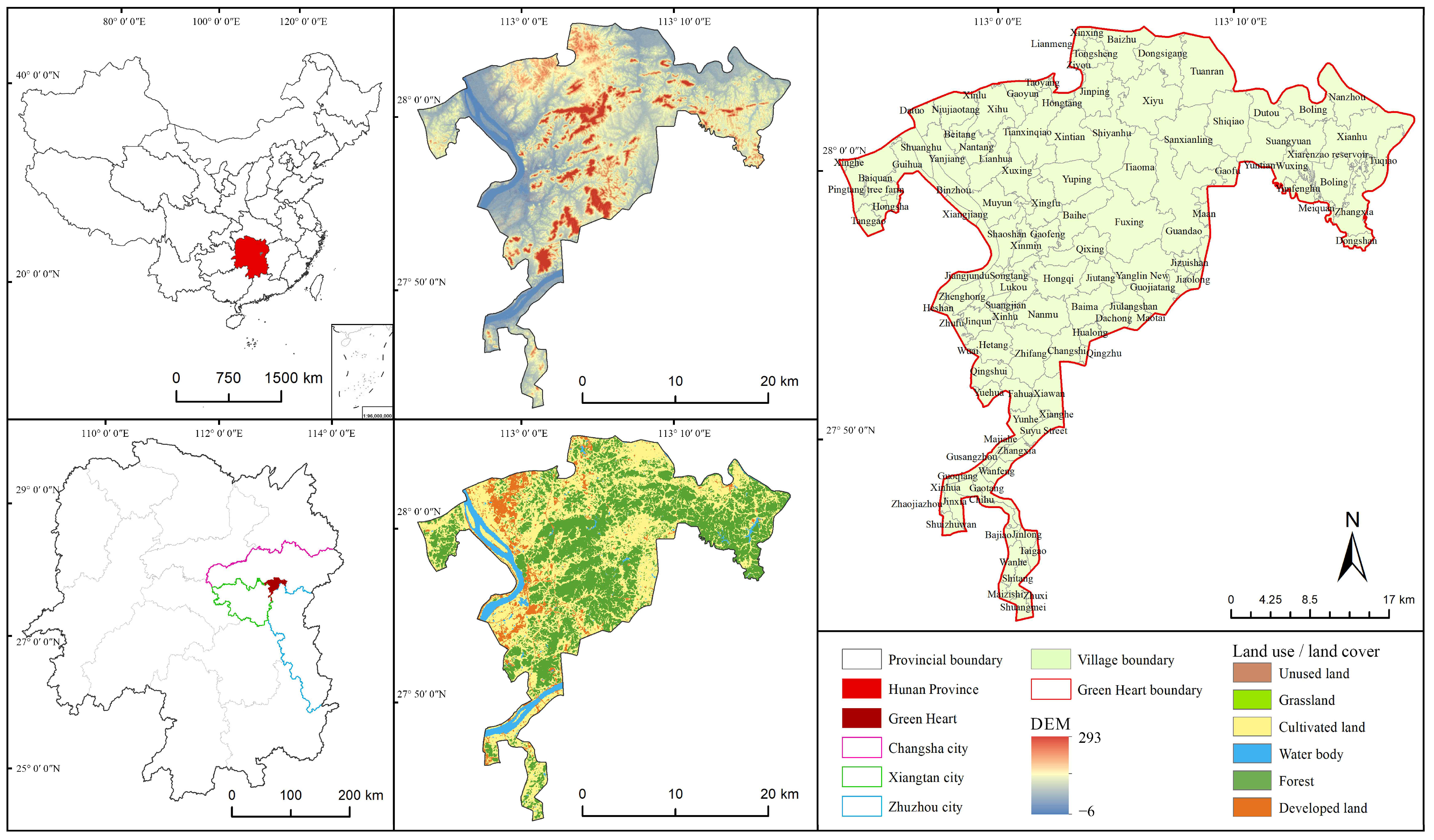
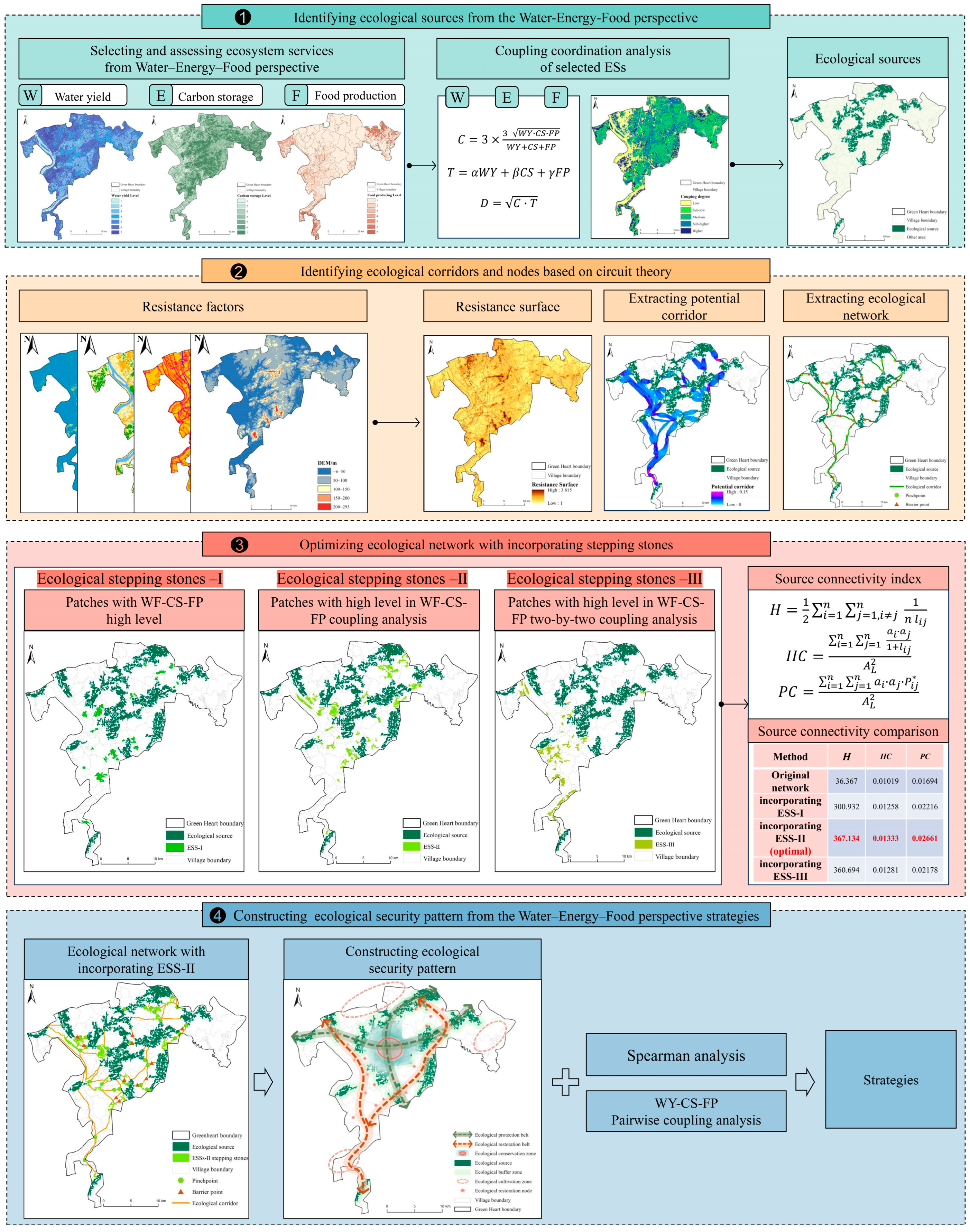
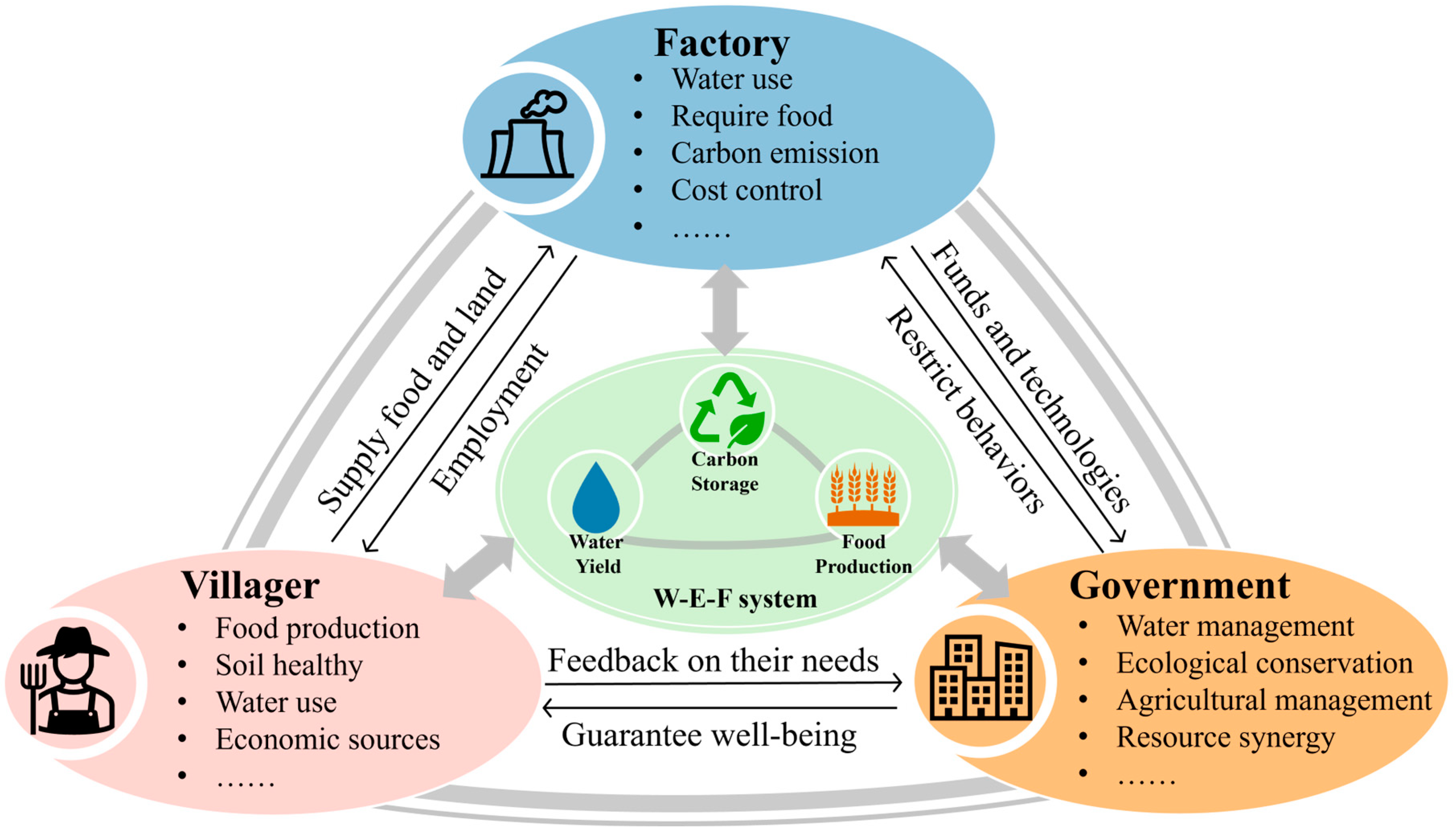

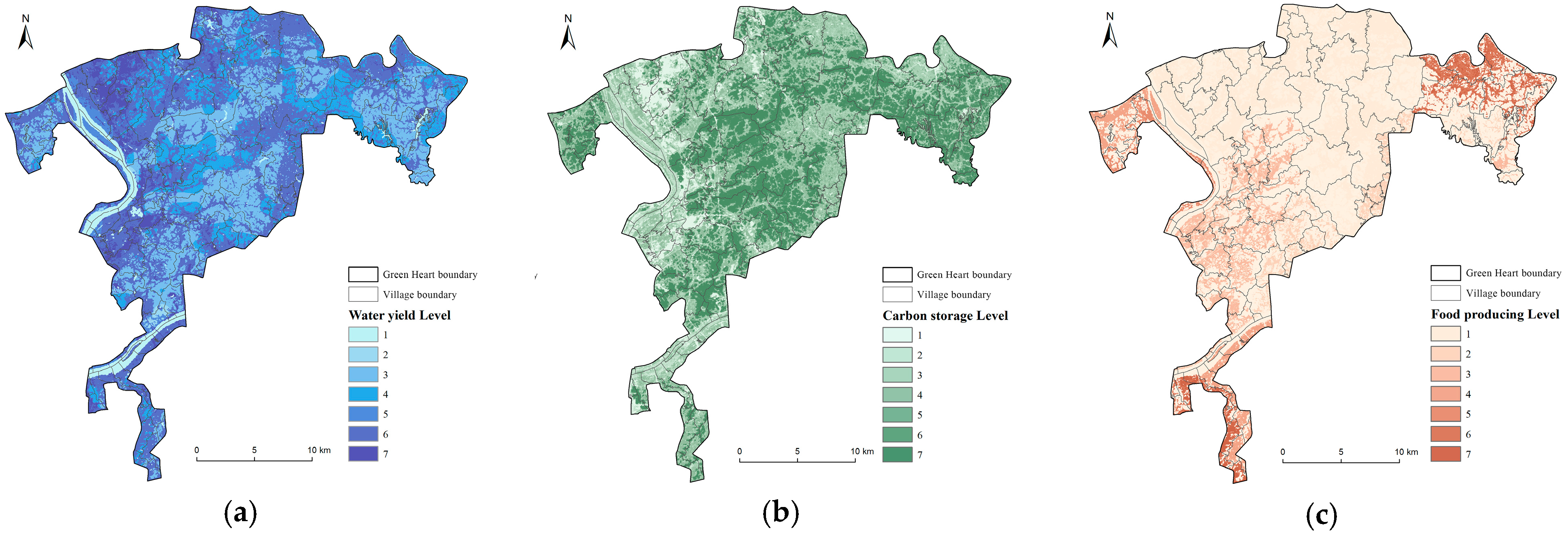
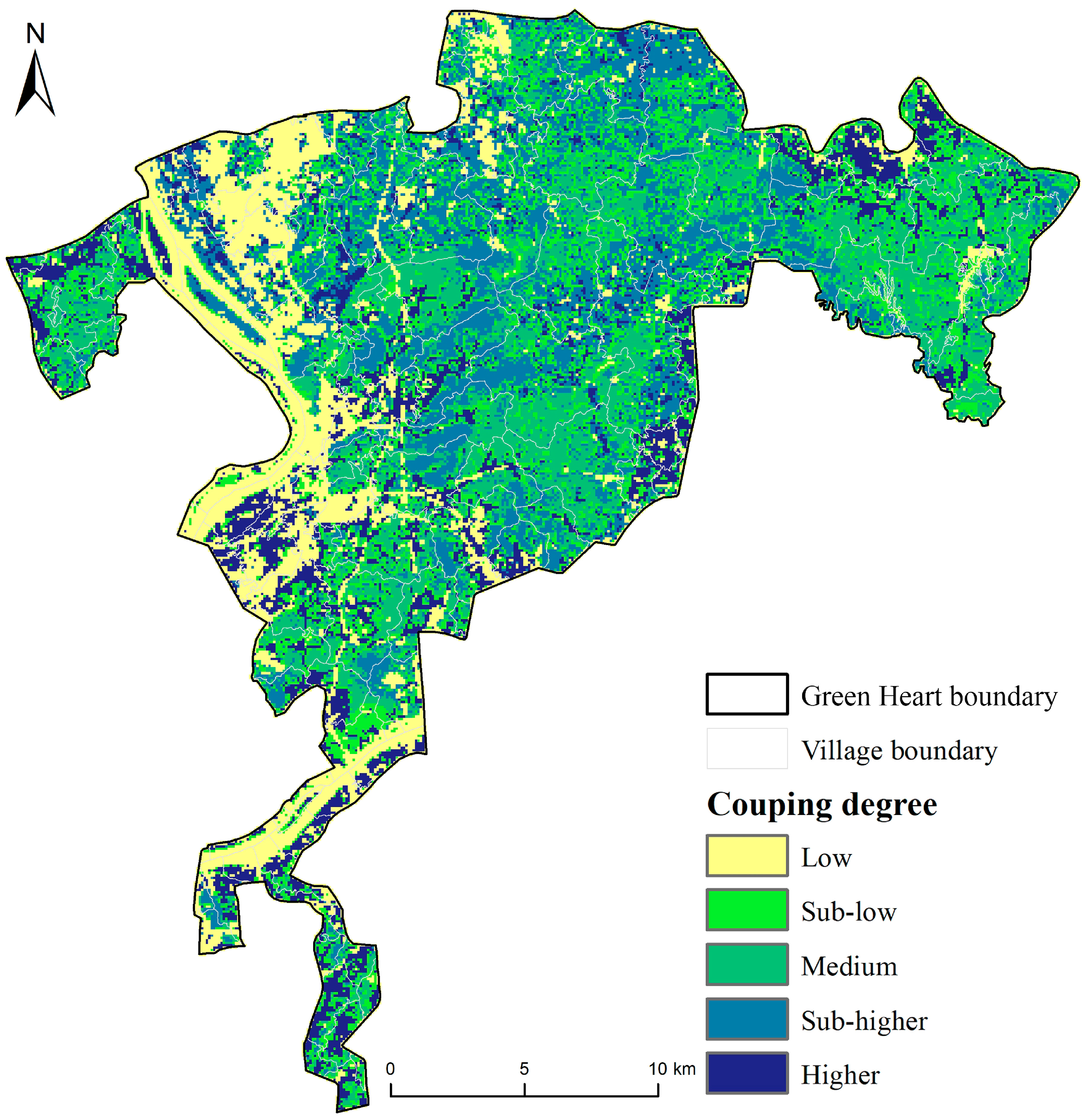

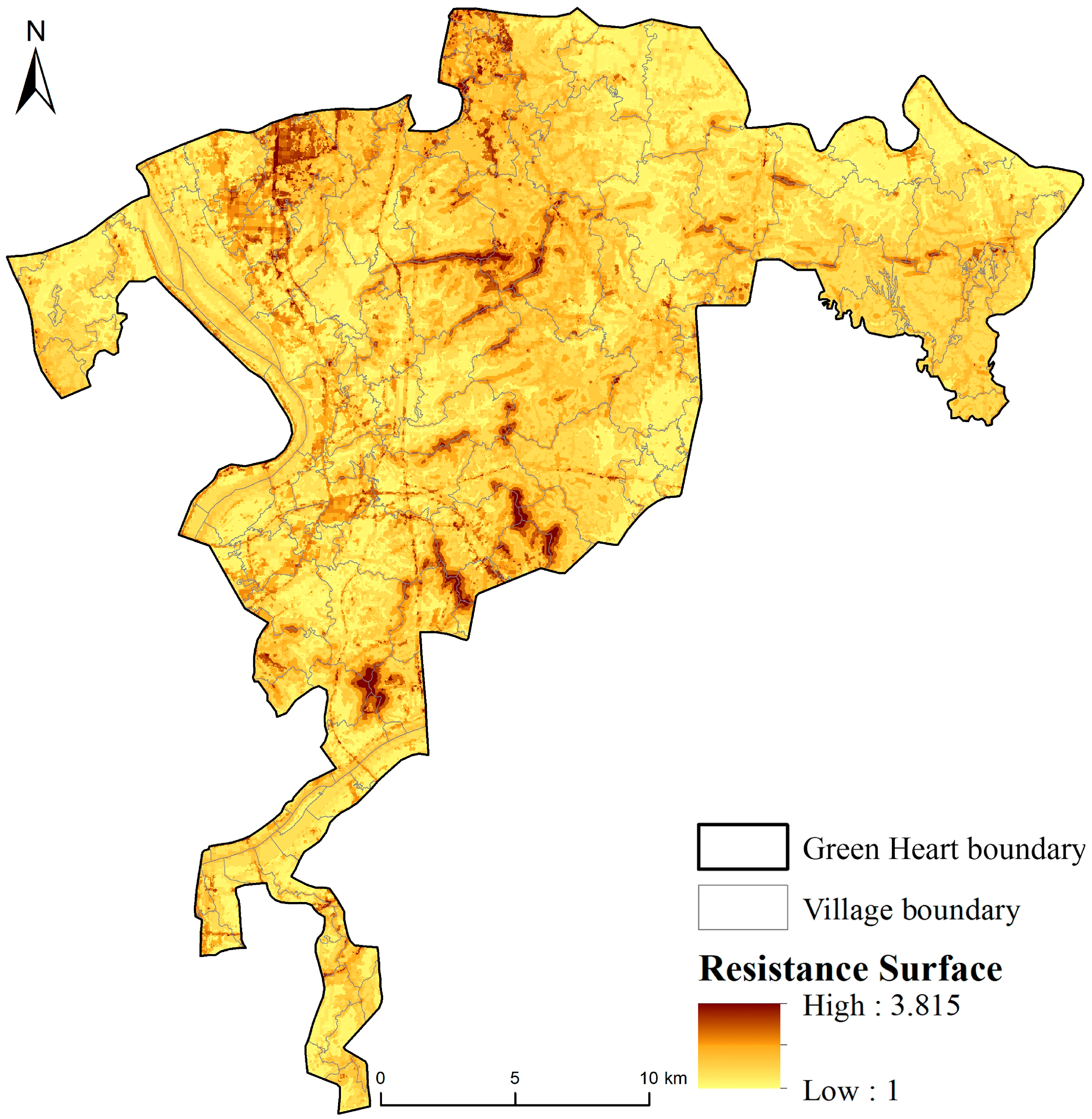
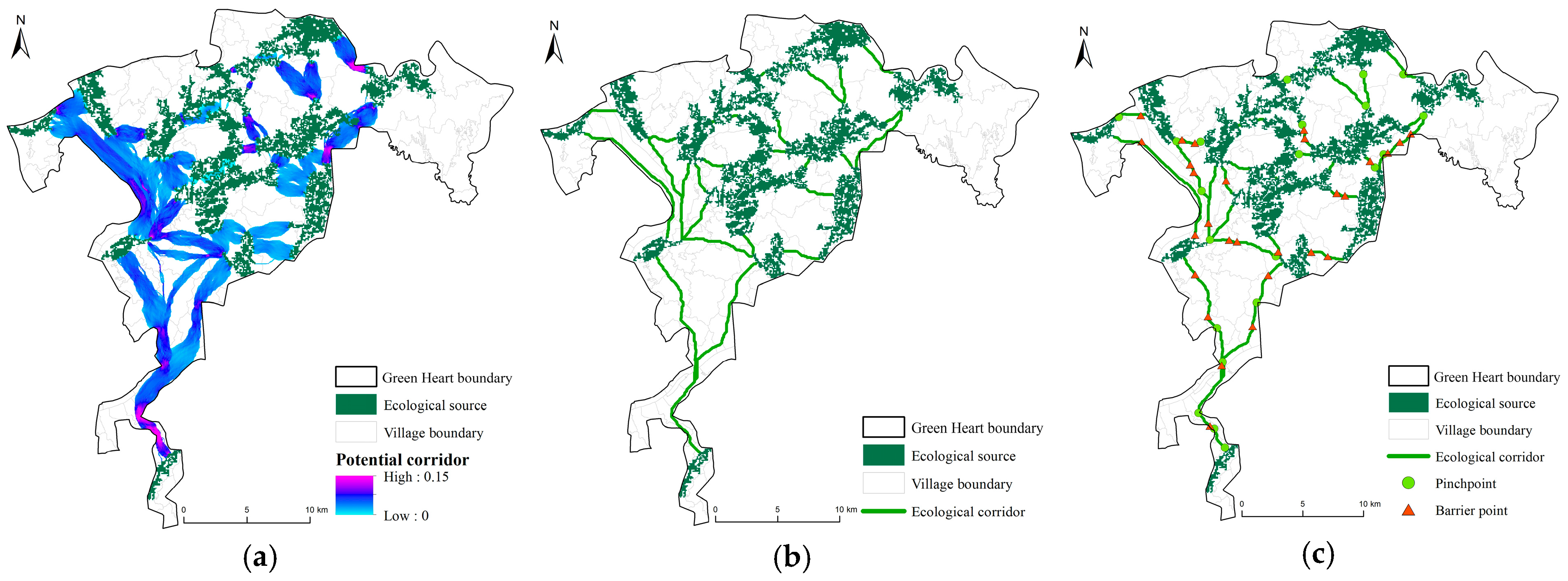
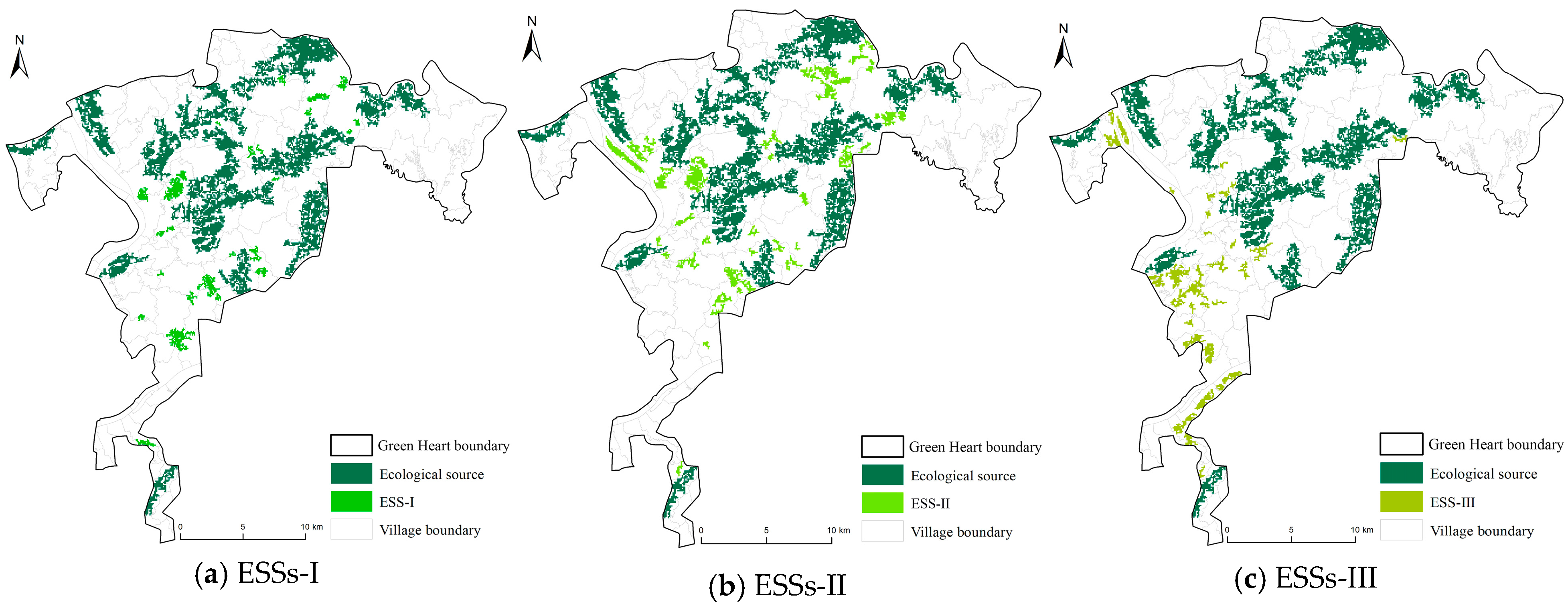
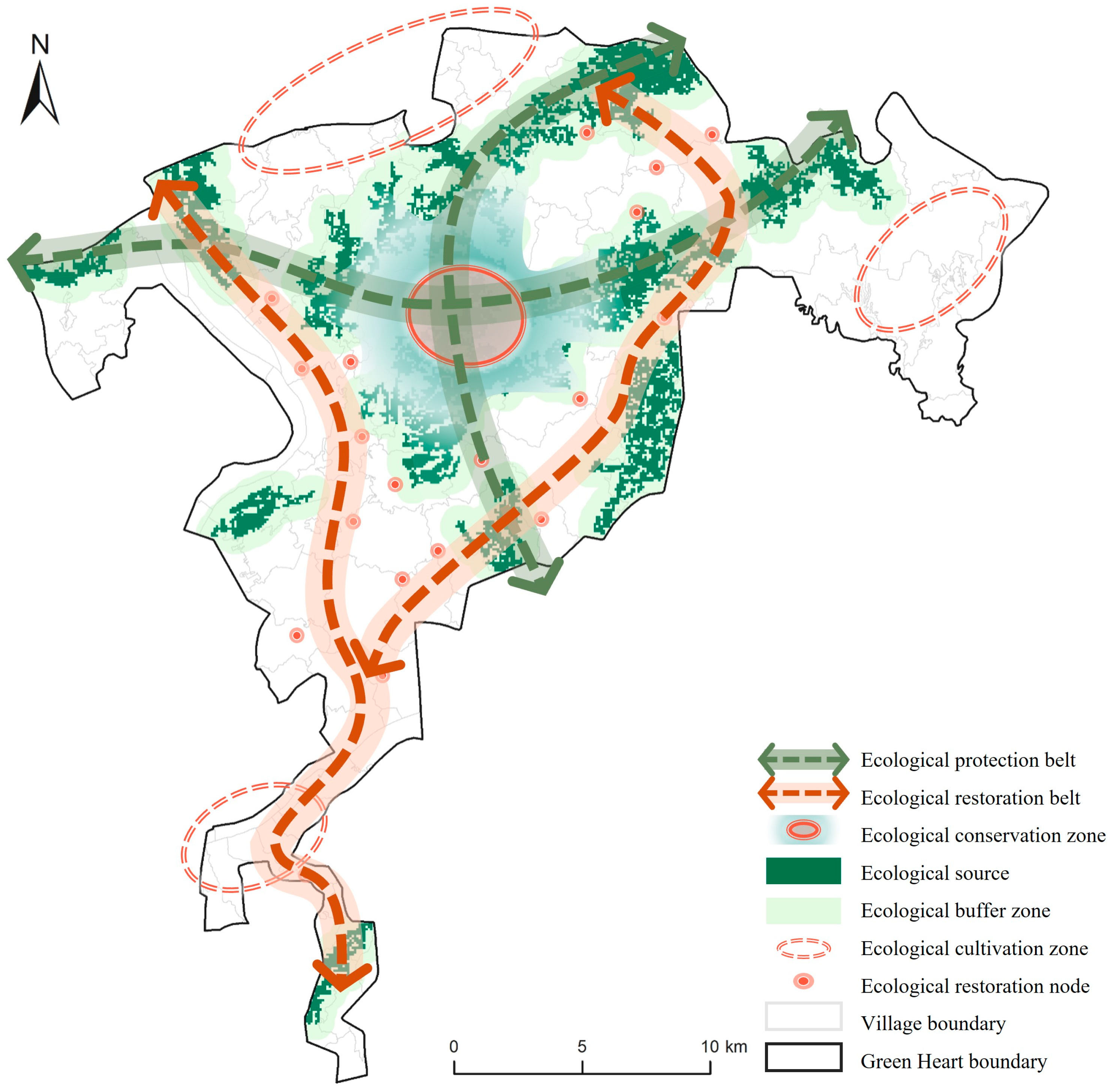


| Dataset and Time | Description | Resolution | Data Source (All accessed on 1 July 2024) | Usage |
|---|---|---|---|---|
| CLCD (2022) | China Land Cover Dataset | 30 m | https://zenodo.org/records/8176941 | WY, CS, FP, resistance surface, correlation |
| DEM (2011) | Digital Elevation Model | 12.5 m | https://www.gscloud.cn/search | Resistance surface |
| PRE (2022) | Precipitation | 1 km | https://www.geodata.cn | WY, correlation |
| PE (2022) | Potential evapotranspiration | 1 km | https://www.geodata.cn | WY |
| DTB (2020) | depth to bedrock | 100 m | http://globalchange.bnu.edu.cn/research/cdtb.jsp#download [46] | WY |
| NDVI (2022) | Normalized Difference Vegetation Index | 30 m | http://www.gis5g.com/data/zbsj/NDVI?id=24 | CS, FP |
| Road (2022) | Road density | - | https://www.openstreetmap.org/ | Resistance surface |
| NTL (2022) | Nighttime lights | 500 m | https://doi.org/10.7910/DVN/YGIVCD | Correlation |
| AAWS (2022) | Annual average wind speed | 1 km | http://www.gis5g.com/ | Correlation |
| RE (2022) | Rainfall erosivity | 1 km | http://www.gis5g.com/ | Correlation |
| SM (2022) | Soil moisture | 1 km | https://cstr.cn/18406.11.Hydro.tpdc.271762 | Correlation |
| AHT (2022) | Annual highest temperature | 1 km | https://www.geodata.cn | Correlation |
| Resistance Factor | Resistance Value | Weight | ||||
|---|---|---|---|---|---|---|
| 1 | 2 | 3 | 4 | 5 | ||
| DEM/m | <50 | 50~100 | 100~150 | 150~200 | >200 | 0.5292 |
| Slope/° | <15 | 15~25 | 25~35 | 35~45 | >45 | 0.2517 |
| Patch–corridor–matrix type | forest, grassland | cultivated land | wetland, water body | unused land | developed land | 0.1637 |
| Density of road | 0~0.0036 | 0.0037~0.025 | 0.026~0.15 | 0.16~0.96 | 0.97~5.9 | 0.0554 |
| Index type | Index | Formula | Interpretation |
|---|---|---|---|
| Binary indices | Harary | n: the number of patches in the study area. : the minimum number of connections between patch i and patch j, where the connections do not exist when is infinite. : the maximum probability of each diffusion path between patch i and patch j; : the multiplied attribute value between patch i and patch j, which is generally the patch area. : the total attribute value of the study area, which is generally the total area of that. The larger the H, IIC, and PC, the higher the area connectivity. | |
| IIC | |||
| Probability index | PC |
| Methods | Corridor | Nodes | Source Connectivity | ||||
|---|---|---|---|---|---|---|---|
| Length (km) | Number | Barrier Points | Pinch Points | H | IIC | PC | |
| Original network | 117.21 | 28 | 28 | 21 | 36.367 | 0.01019 | 0.01694 |
| Incorporating ESSs-I | 164.19 | 100 | 11 | 22 | 300.932 | 0.01258 | 0.02216 |
| Incorporating ESSs-II | 153.57 | 96 | 11 | 31 | 367.134 | 0.01333 | 0.02661 |
| Incorporating ESSs-III | 132.79 | 95 | 14 | 31 | 360.694 | 0.01281 | 0.02178 |
Disclaimer/Publisher’s Note: The statements, opinions and data contained in all publications are solely those of the individual author(s) and contributor(s) and not of MDPI and/or the editor(s). MDPI and/or the editor(s) disclaim responsibility for any injury to people or property resulting from any ideas, methods, instructions or products referred to in the content. |
© 2025 by the authors. Licensee MDPI, Basel, Switzerland. This article is an open access article distributed under the terms and conditions of the Creative Commons Attribution (CC BY) license (https://creativecommons.org/licenses/by/4.0/).
Share and Cite
Tian, J.; Zhang, B.; Li, J.; Zhang, A.; Zhu, L. Incorporating Stepping Stone Establishment into Rural Ecological Security Pattern Optimization: A Water–Energy–Food Coupling Perspective. Land 2025, 14, 862. https://doi.org/10.3390/land14040862
Tian J, Zhang B, Li J, Zhang A, Zhu L. Incorporating Stepping Stone Establishment into Rural Ecological Security Pattern Optimization: A Water–Energy–Food Coupling Perspective. Land. 2025; 14(4):862. https://doi.org/10.3390/land14040862
Chicago/Turabian StyleTian, Jingwen, Bolun Zhang, Jiaying Li, Anxiao Zhang, and Ling Zhu. 2025. "Incorporating Stepping Stone Establishment into Rural Ecological Security Pattern Optimization: A Water–Energy–Food Coupling Perspective" Land 14, no. 4: 862. https://doi.org/10.3390/land14040862
APA StyleTian, J., Zhang, B., Li, J., Zhang, A., & Zhu, L. (2025). Incorporating Stepping Stone Establishment into Rural Ecological Security Pattern Optimization: A Water–Energy–Food Coupling Perspective. Land, 14(4), 862. https://doi.org/10.3390/land14040862










